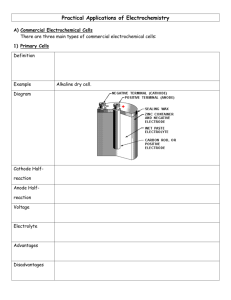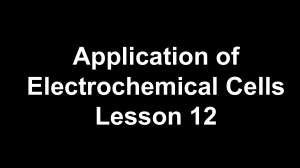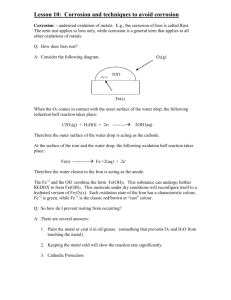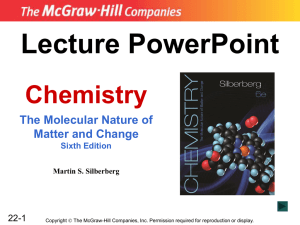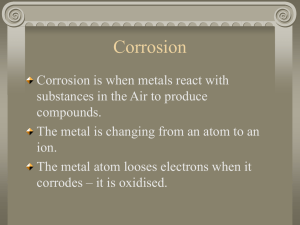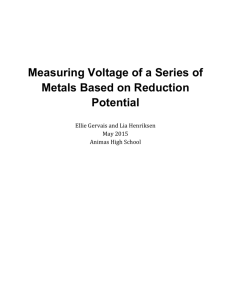Lesson 8: Odds & Ends
advertisement
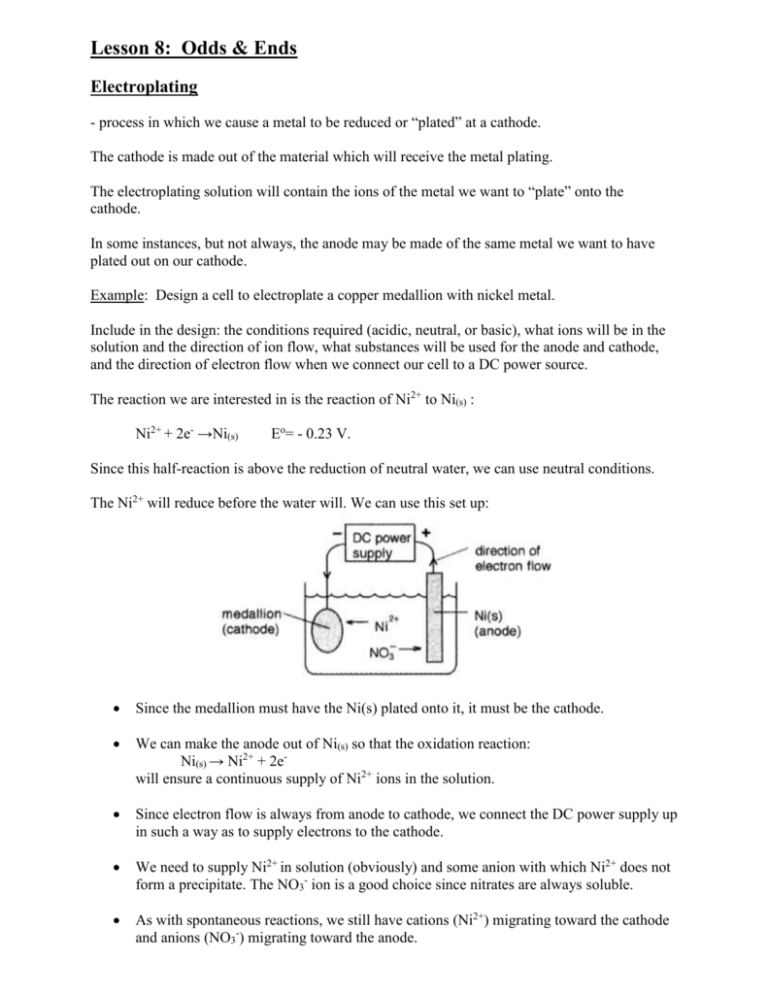
Lesson 8: Odds & Ends Electroplating - process in which we cause a metal to be reduced or “plated” at a cathode. The cathode is made out of the material which will receive the metal plating. The electroplating solution will contain the ions of the metal we want to “plate” onto the cathode. In some instances, but not always, the anode may be made of the same metal we want to have plated out on our cathode. Example: Design a cell to electroplate a copper medallion with nickel metal. Include in the design: the conditions required (acidic, neutral, or basic), what ions will be in the solution and the direction of ion flow, what substances will be used for the anode and cathode, and the direction of electron flow when we connect our cell to a DC power source. The reaction we are interested in is the reaction of Ni2+ to Ni(s) : Ni2+ + 2e- →Ni(s) Eo= - 0.23 V. Since this half-reaction is above the reduction of neutral water, we can use neutral conditions. The Ni2+ will reduce before the water will. We can use this set up: Since the medallion must have the Ni(s) plated onto it, it must be the cathode. We can make the anode out of Ni(s) so that the oxidation reaction: Ni(s) → Ni2+ + 2ewill ensure a continuous supply of Ni2+ ions in the solution. Since electron flow is always from anode to cathode, we connect the DC power supply up in such a way as to supply electrons to the cathode. We need to supply Ni2+ in solution (obviously) and some anion with which Ni2+ does not form a precipitate. The NO3- ion is a good choice since nitrates are always soluble. As with spontaneous reactions, we still have cations (Ni2+) migrating toward the cathode and anions (NO3-) migrating toward the anode. Corrosion and techniques to avoid corrosion Corrosion: - undesired oxidation of metals. E.g., the corrosion of Iron is called Rust. The term rust applies to Iron only, while corrosion is a general term that applies to all other oxidations of metals. Q: How does Iron rust? A: Consider the following diagram. O2(g) Fe+2 H2O Fe(s) When the O2 comes in contact with the outer surface of the water drop, the following reduction half reaction takes place: 1/2O2(g) + H2O(l) + 2e- --------- 2OH-(aq) Therefore the outer surface of the water drop is acting as the cathode. At the surface of the iron and the water drop, the following oxidation half reaction takes place: Fe(s) ----------- Fe +2(aq) + 2eTherefore the water closest to the Iron is acting as the anode. The Fe+2 and the OH- combine the form Fe(OH)2. This substance can undergo further REDOX to form Fe(OH)3. This molecule under dry conditions will reconfigure itself to a hydrated version of Fe2O3(s). Each oxidation state of the Iron has a characteristic colour; Fe+2 is green, while Fe+3 is the classic red/brown or “rust” colour. Q: So how do I prevent rusting from occurring? A: There are several answers: 1. Paint the metal or coat it in oil/grease. (something that prevents O2 and H2O from touching the metal). 2. Keeping the metal cold will slow the reaction rate significantly. 3. Cathodic Protection Q: What is cathodic protection??? A: Protecting a metal by contacting it with a more reactive one. E.g., metals are often coated with Zinc because Zinc tends to be more reactive than the metals we are trying to protect. Metals that are coated this way are said to be galvanized. Nails are often coated in Zinc to prevent the iron underneath it from rusting. e.g., cathodic protection can also be used to protect boat motors or metal pipes. See the diagram below. Magnesium band Iron pipe In this case, the Magnesium is a stronger reducing agent than the Iron pipe. When the Magnesium reacts it oxidizes according to the following half equation: Mg(s) ------------------ Mg+2(aq) + 2eThe electrons lost by the Mg are deposited on the Iron forcing the Iron to be a cathode (b/c only reduction happens at the cathode, it is impossible for oxidation of the iron to occur!) Standard reduction Potentials (Eo) “Standard” conditions for electrochemical cells are listed in the data booklet on pg.8 - 25oC - 1M solutions are used for each half-cell. Eo = The voltage, or the work done per electron transferred (which is why we do not have to multiply voltage when adjusting the number of e- in two half-equations). The “o” means the voltage occurs in standard conditions. The Zero voltage for Hydrogen is arbitrary, and the remaining voltages on the REDOX table simply represent the difference in voltage between the two half-cells. Things to watch out for! 1. Changing the surface area of an electrode does not change the voltage of a cell. Since metals are pure, there is no increased tendency to react. (We are not talking about the rate of the reaction). 2. Decreasing the concentration of a solution will decrease the voltage b/c there will be a decreased tendency to react. (opposite is true for inc conc) 3. Operating cells are NOT in equilibrium ( a cell in equilibrium has a voltage of Zero. i.e., it’s dead, it’s not operating!)

